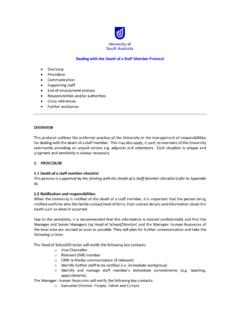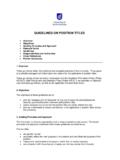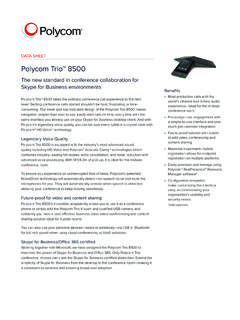Transcription of Skype for Business User Guide - University of South …
1 Skype for Business user Guide Contents Accessing Skype for Business .. 2 Starting Skype for Business for the first Customising Skype for Business start-up ..2 Skype for Business basics .. 2 The main Skype for Business window ..2 Displaying your availability: Presence ..3 Contacts .. 4 Creating a group ..4 Finding and adding Communicating with your contacts .. 5 Instant messaging (IM) ..5 Making an audio or video call ..6 Conversation History ..7 Skype for Business meetings .. 7 Scheduling a Using the Skype for Business Web App to join a meeting (external guests) ..8 Starting an unscheduled meeting ..9 Sharing your desktop and other content .. 10 Start sharing .. 10 Allowing participants to control 12 Exiting Skype for Business .
2 12 Closing the Skype for Business 13 Sign 13 13 2 Skype for Business user Guide What is Skype for Business ? This Guide is for people who are new to Skype for Business , and provides information on how to begin using it to communicate with your colleagues. Skype for Business was formerly known as Lync but was re-branded under the current release name after Microsoft acquired Skype . It is a communications platform that allows you to interact with your contacts using instant messaging (IM), audio and video conversations, and Skype for Business Meetings. It runs on Windows and Mac operating systems, and on mobile devices. Accessing Skype for Business Starting Skype for Business for the first time Windows desktop: The Skype for Business Windows client is installed by default as part of the Office suite.
3 Click the Windows start button at the bottom left of your screen Select All Programs > Microsoft Office 2013 > Skype for Business 2015 When the Skype for Business window appears, enter your Sign-in address and then click the Sign In button. It will then request your password. Enter your everyday network password. When Skype for Business is running, you will see a large Skype for Business icon on the Windows taskbar, and a small Skype for Business icon in the system tray at the end of the task bar. Closing the Skype for Business window does not close the application, but merely minimises the window, which can then be opened by clicking the large taskbar icon. The small system tray icon only provides access to a few select commands, and doesn t open the Skype for Business window, but you can right-click it to quickly update your status and exit Skype for Business .
4 Customising Skype for Business start-up You can change your default Skype for Business start-up options using the Options menu (cog icon) on the main screen, then choosing Tools > Options. Once the Options window opens, select Personal from the left hand panel, then make the required changes, such as unticking Start . Skype for Business basics The main Skype for Business window When you sign into Skype for Business , the main window will appear: 3 Skype for Business user Guide Displaying your availability: Presence A user s availability is indicated by the coloured icon beside their profile picture. This availability status is known as your presence and will indicate a status such as Available, Busy, Away, Do Not Disturb, etc. Your presence indicator will effect which communication options are available.
5 Presence is only indicated for those with the Skype for Business client running, otherwise it will show as Offline (uncoloured). Indicators are based on your Outlook calendar information, but update according to both your calendar and your activity. For instance, if you are available at your desk but don t use your mouse or keypad for a period of time (the default is five minutes, but this can be changed), Skype for Business automatically changes your presence indicator from green to an inactive yellow icon. Using your keyboard or mouse returns your status to available. You can also manually change your availability by: Using the drop-down status menu in the Skype for Business window Hovering over the large icon on the task bar Right-clicking the small icon on taskbar 4 Skype for Business user Guide Manual status settings override all automatic changes.
6 To return to automatic settings, select Reset Status from the status drop-down menu. As Skype for Business is integrated with Outlook, you will automatically see the availability of colleagues when you communicate with them by email. When you append a name to the address field in a new email you will also see their presence status displayed beside the name. Guide to status icons If your Outlook calendar is set to Out- of-Office, but your Skype presence is set to Available (for instance, if you were working from home), there would be a purple dot displayed beside the status, as shown above * Set automatically for you based on your keyboard activity or Outlook calendar.
7 ** You can set your presence to this anytime you want. Contacts When you first start using Skype for Business , it is worth investing some time setting up contacts and groups so that you can easily communicate with people that you frequently interact with. Creating a group In the main Skype for Business window, click the Add a Contact icon , then choose Create a New Group Alternatively, right-click any group name in your contacts list ( Other Contacts), and then click Create New Group. A New Group box will appear. Rename it by overwriting the text so that the new name is meaningful to you.
8 Your group has been created, and you can start adding contacts to it directly from the search field as described in the next section. 5 Skype for Business user Guide Finding and adding contacts From the Company Directory In the main Skype for Business window start typing the name in the search box. A list of matching people from your Contacts will appear. Right-click on the required name and select Add to Contacts List or you can add them directly to one of your listed contact groups. You can also add contacts from the Add a Contact icon , then choose Add a Contact in My Organisation. Communicating with your contacts To communicate with a contact, use one of the following methods to access the communication tools, then select the option you want to use ( instant message, video call, etc).
9 Hover your mouse over their picture in the contacts list: Double-click anywhere on their contact listing: Right-click their contact listing: Instant messaging (IM) Instant messaging (IM) allows you to communicate with people in real time, and on a moment s notice. It is less formal than email, and faster than a phone call. You can have an IM conversation with one or many people, send pictures and files or add audio or video. Starting an IM conversation with one person Locate the person you want to send an instant message to. Display the communication options for that person using one of the above methods; choose the instant messaging icon. A conversation window will appear. Type your message at bottom of the conversation window and press the return key or click the send icon (>).
10 Your conversation appears at the top of the conversation window. You can also 6 Skype for Business user Guide click options to add an attachment, emoticons, or mark the message as important. 7 Skype for Business user Guide Responding to an IM alert When someone starts a new IM conversation with you, an alert pops up on your screen. To see the message, click anywhere on the photo area to accept it. The IM conversation window will open to display the message. To reject the message, click Ignore. The message request will go to your Outlook Inbox as a missed message. If you do not want to receive new IM alerts, set your presence status to Do Not Disturb. You can do this from the Options menu on an incoming IM alert box, or changing your status in the main Skype for Business window.












